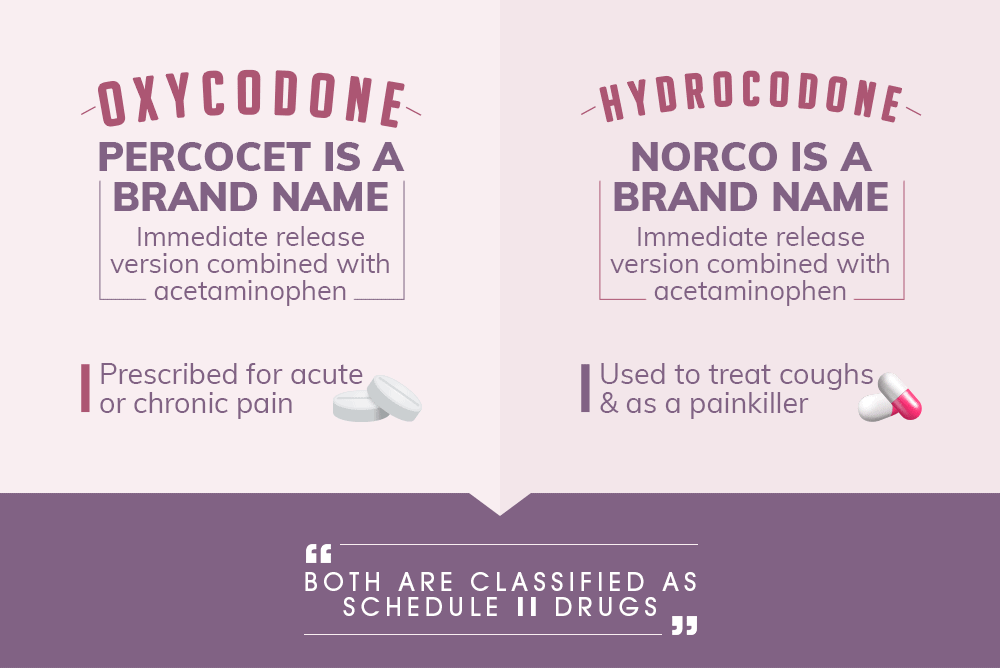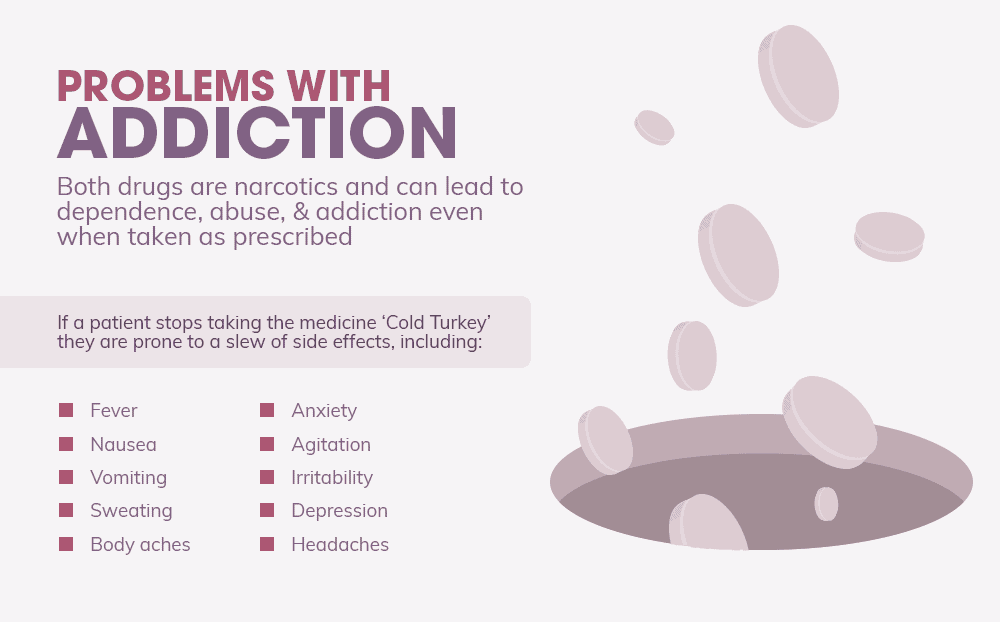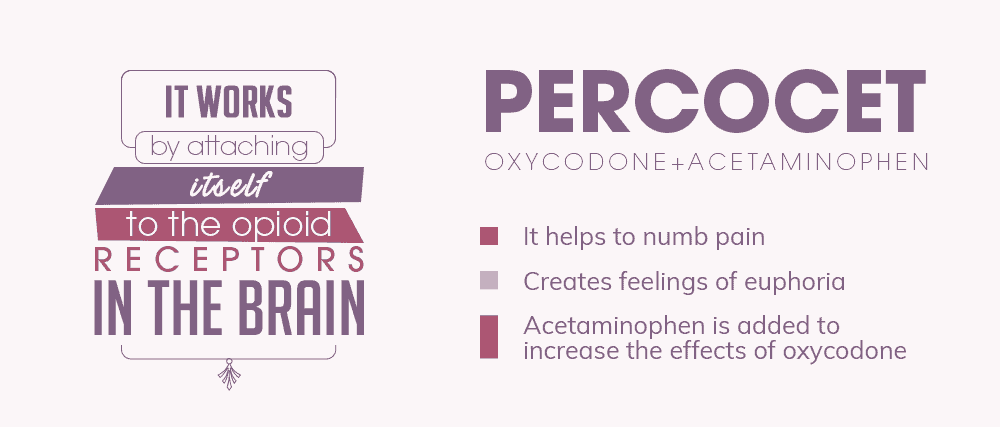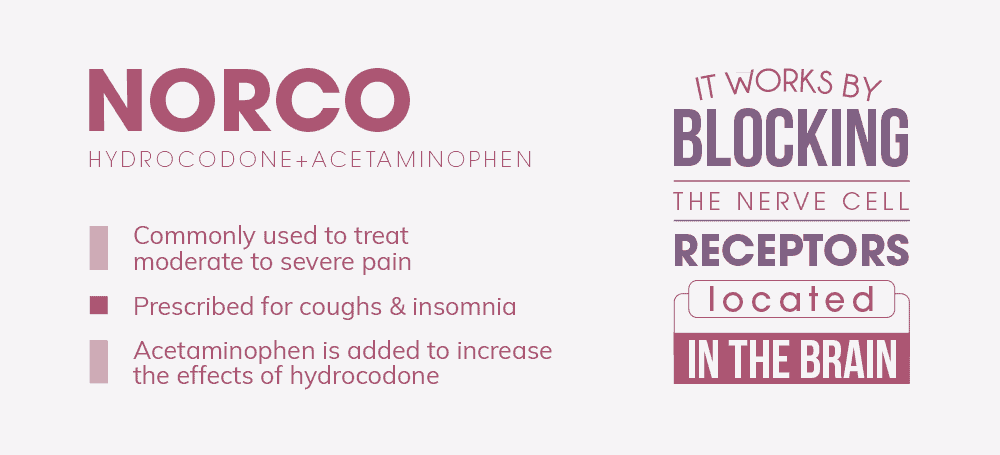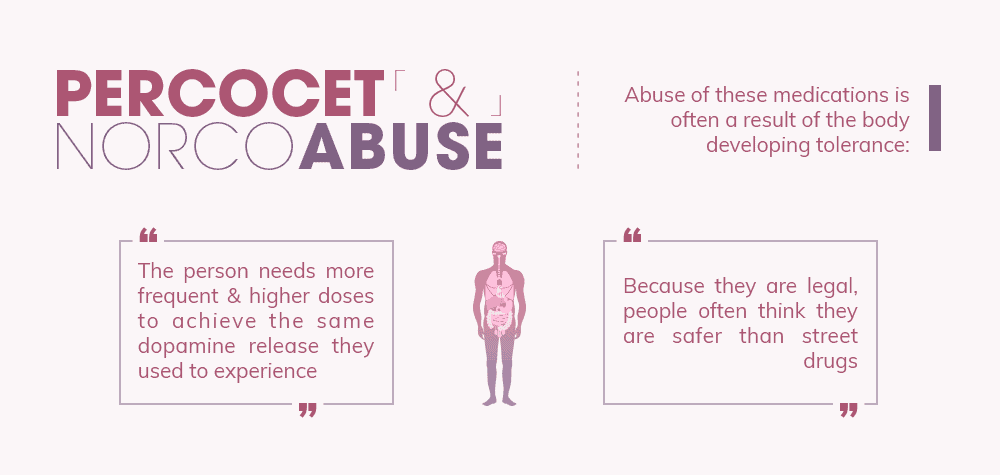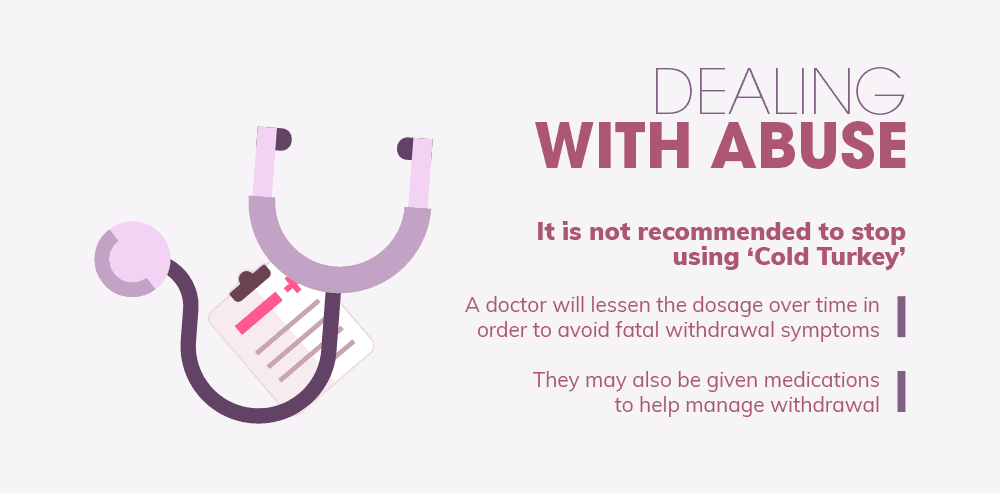Certain prescription medications can be addictive for some people. They are often used for pain, but they contain chemical properties that lead to abuse and addiction. Two of the drugs in this category are Percocet and Norco. Derived from Oxycodone and Hydrocodone, these two medications can be dangerous, especially for someone with an addictive past. If you take either one of these medications or know someone who is taking or has taken them, you may want to know more about how they can lead to addiction. You may wonder if one prescription drug is better or safer than the other. Learn the details of these medications and how to help someone who has become addicted to a prescription drug. 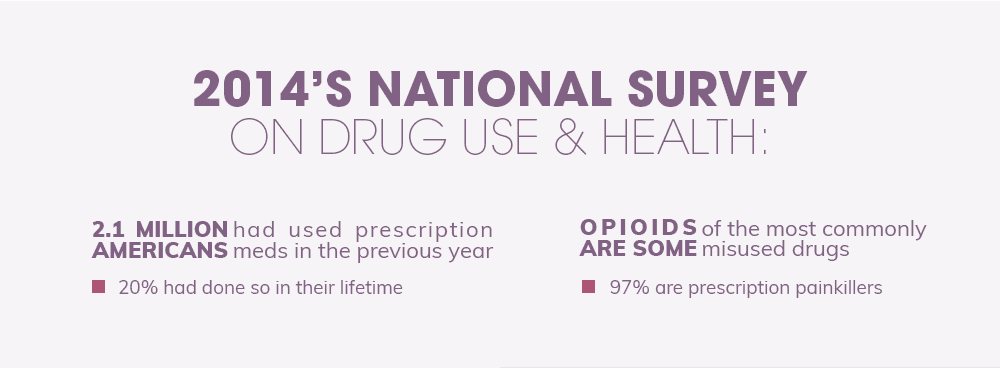
“Get your loved one the help they need. Our substance use disorder program accepts many health insurance plans, this is our residential program.”
Oxycodone vs. Hydrocodone
Two of the most commonly abused pain medications are oxycodone and hydrocodone. You or someone you know has probably received a prescription for one of these medications. Find out what they are, why they are prescribed and how a person can become addicted to them.
What is Oxycodone?
This medication is an opioid which is developed form the poppy plant where you will also find heroin and morphine. It’s a semi-synthetic version, which means it’s natural state is altered through chemical changes to improve on the older versions. Oxycodone is sold under various brand names which you may be more familiar with, such as OxyContin and Percocet. Oxycodone isn’t a new medicine. It’s been around since 1916, and it has been developed for moderate to severe pain. It may be prescribed for acute or chronic pain. You can take it by mouth or be given it through an injection. There are multiple formulations for this pain medication, which is given for different reasons. Some versions include the following:
- Roxicodone – immediate release drug
- OxyContin – controlled release with up to 12 hours of duration
- Percocet – immediate release version combined with acetaminophen
- Targin – 12-hour release formula with naloxone
The United States has only approved the use of oxycodone orally in solutions and tablets. It has been used to treat chronic pain which results from a cancer diagnosis as well as acute pain from an injury or surgery. Doctors will prescribe a version of this drug to children as young as 11 years of age.
What is Hydrocodone?
This medication is also a derivative of the poppy plant. Like oxycodone, it’s also a semi-synthetic version. It comes from codeine, which is an opioid alkaloid you can find in the plant. You may recognize the name codeine as an ingredient found in cough medicines. Hydrocodone is also used to treat coughs as well as working as a painkiller. Some variations of hydrocodone include the following:
- Vicodin – immediate release version with acetaminophen
- Lorcet – immediate release version with acetaminophen
- Reprexain – immediate release with ibuprofen
- Azdone – immediate release with aspirin
- Norco – immediate release with acetaminophen
This medication is taken orally and mostly used in the United States. It’s classified as a Schedule II drug.
The Differences Between Oxycodone and Hydrocodone
Both of these drugs have the same origin. However, they aren’t alike and may be prescribed for different reasons. They treat acute pain as well as chronic cases. Most often the pain level is moderate to severe, and other medications may not work. Because they are opioids, they change the way the brain reacts and recognizes pain. In the past, hydrocodone was labeled Schedule III while oxycodone was always labeled Schedule II. Now, both drugs are in this higher classification. Drugs are placed in certain schedules based on how addictive they are. It was once thought that oxycodone was more addictive because it often appears to be more potent. However, experts now recognize that hydrocodone is also addictive. Both drugs come with a variety of side effects. However, the most common side effects for oxycodone are drowsiness and dizziness. Hydrocodone is more likely to lead to stomach pain and constipation. All opioids are dangerous for women who are pregnant, including these two. They may increase the risk for birth defects, especially when taken for a longer time. Women who are breastfeeding shouldn’t take either of the drugs because the medication can be transferred through breast milk.
Problems with Addiction
Since these drugs are derived from the poppy plant and are opioids, they share one important thing in common. They can lead to addiction even when taken properly. Although you follow the dosage instructions given by the doctor, it’s possible to become addicted. If you abuse these drugs, you’re more likely to suffer from addiction. Oxycodone and hydrocodone are labeled as narcotics. They are controlled substances, which must be managed carefully. If you stop taking them all at once, you could suffer from withdrawal symptoms. These symptoms can include the following:
- Nausea
- Fever
- Vomiting
- Body aches
- Chills or sweating
- Runny nose
- Headaches
- Watery eyes
- Irritability
- Agitation
- Anxiety
- Thoughts of suicide
- Depression
- Insomnia
- Inability to concentrate or loss of memory
You may also experience cravings for the drug. To avoid these issues when you’re given the medications for pain relief or other medical conditions, a doctor may have you taper off the dosage over a period of days or even a few weeks. Both of these drugs should be managed carefully, and you should be aware of the potential for addiction or abuse.
“We treat both addiction and co-occurring disorders and accept many health insurance plans. Take a look at our inpatient program.”
Percocet vs. Norco
Percocet is a version of oxycodone and Norco is a version of hydrocodone. They aren’t the same drug, but they are used to treat many of the same conditions. Both of these medications may lead to Percocet addiction even if managed properly. They may also be abused by people for nonmedical use. If you have a loved one using one of these drugs or you’ve been prescribed one, you should learn more about them, especially if you’re concerned with the potential for addiction.
What is Percocet?
This medication is a prescription opioid painkiller given for relief of severe pain. It’s a synthetic opioid which means it was made in a lab instead of found naturally. It’s formulated with acetaminophen and oxycodone. It works the same way as other opioids by attaching to the opioid receptors in the brain. It helps numb pain and creates feelings of euphoria. Acetaminophen is added to increase the effect of the oxycodone. It’s not recommended to take Percocet if you’ve recently taken a sedative or tranquilizer or had alcohol. This medication can cause your breathing to slow down. If a doctor has prescribed this drug for pain relief, you should take it exactly as directed and swallow the pill whole. Percocet can be dangerous if you have asthma or lung disease. It can also cause problems if you have a history of drug abuse or addiction. Don’t increase the dosage on your own or take it longer than what has been prescribed. You also don’t want to stop taking it all at once or without a doctor’s approval. Make sure you keep your medication locked up so that no one else can get access to it. Once you stop taking it, you should get rid of the medication. Some places have a take-back program for medications. Otherwise, you can flush the extra pills down the toilet. People who abuse Percocet will often crush the pill so they can inhale the powder or mix it with a liquid to inject it. When they do this, it allows the medication to be absorbed into the bloodstream faster for that high they’re looking for.
Overdosing on Percocet
It’s possible to take too much of this medication and overdose. Because it slows the breathing, you could be in danger of becoming unconscious if you take more than you should. The first signs that someone may have overdosed include loss of appetite, vomiting or nausea, sweating and stomach aches. The person may also feel weak and act confused. Your breathing may slow down along with your heart rate. You may begin to feel extremely drowsy and have weak muscles. If you find someone acting strangely after taking Percocet, check for skin that’s cold and clammy and pinpoint pupils. Fainting is another indication of overdose. You need to get emergency medical help because an overdose could be fatal.
Mixing Percocet and Other Substances
Some people will combine this medication with other drugs. They may do it to get high or to prolong the euphoria. However, some may combine medications without meaning to do anything dangerous. Because Percocet contains acetaminophen, you must be careful when taking other medications that have this ingredient. Too much acetaminophen can be fatal. You’ll find this ingredient in cold and allergy medicines as well as sleep medications. Don’t drink alcohol when you’re taking Percocet. The alcohol can depress your central nervous system and the medication can slow your breathing. When combined, you’re at a greater risk for death.
Side Effects of Percocet
Even when taken as directed by a doctor, Percocet may have serious side effects. Some of the most common of these may include the following:
- Headaches
- Dizziness
- Fever
- Chills
- Abdominal pain
- Loss of appetite
- Rash
- Vomiting blood
- Yellow skin or eyes
- Unusual weakness or tiredness
Symptoms that are rarer but still considered serious include unusual bleeding or noticeable bruising, painful urination or difficulty urinating, pain in the lower back or side and a sore throat. You may also have sores in the mouth or on the lips. Some of these symptoms aren’t as serious and may go away in time as your system adjusts to the medication. However, if you’re concerned about any of the side effects or notice them worsening, you should contact a doctor right away. It’s also important to know about these side effects if you’re using this medication on a recreational basis.
What is Norco?
Norco is a narcotic which is made up of hydrocodone and acetaminophen. Hydrocodone is an opioid. Acetaminophen increases the effects of the opioid so that it’s more effective in treating pain. It’s given in tablet form with one to two tablets taken about every 4-6 hours. The maximum dosage is generally eight tablets per day. The dosage is usually adjusted based on the level of pain the person is experiencing. The hydrocodone in the medication works by blocking the nerve cell receptors located in the brain. While it’s most commonly used to treat moderate to severe pain, some doctors have prescribed it for coughs as well as insomnia. Norco has been around since 1997 when it was approved by the FDA.
Overdosing on Norco
It’s possible to overdose on Norco if you take too much. This is especially true because of the acetaminophen included in the medication. Since this ingredient is also found in many other medications, you can get a fatal amount of it in your system, even when taking it as prescribed. You should contact emergency medical help right away if you think you’ve taken an overdose. Signs that a person has overdosed on Norco include the following:
- Extreme sleepiness
- Cold or clammy skin
- Slowed heart rate and breathing
- Low blood pressure
Eventually, the person may go into a coma. If the overdose is caused by too much acetaminophen, they may have a loss of appetite, nausea and vomiting, dark urine, stomach pain, and jaundice. You need to get medical attention right away for an overdose.
Side Effects of Norco
Norco contains some serious side effects even if you take it exactly as prescribed. It must include what is known as a black box warning because of the acetaminophen in the drug. One warning is for liver damage while another one is for the possibility of allergic reactions. Hydrocodone can slow down your breathing and even stop it. You should let your doctor know if you’ve had a head injury or seizures. Also tell them about any diagnosis of asthma or other pulmonary diseases, which could affect the results of the medication. This is a highly addictive drug, especially if a person has a history of drug abuse. It’s essential that you tell your doctor of this previous history before taking the medication. You shouldn’t take it If your pregnant or nursing because it can cause withdrawal in a baby. Some of the most common side effects of Norco include dizziness, drowsiness, constipation and nausea and vomiting. These may go away with continued use or if the doctor alters the dosage. However, other side effects may be more serious. They include:
- Lightheadedness
- Confusion
- Convulsions
- Shallow or slow breathing
- Slow heartbeat
- Difficulty urinating
- Rash or redness of the skin
- Anxiety of depression
- Mood swings
- Itching
- Upper abdominal pain
- Loss of appetite
You should seek medical help immediately if you notice any of these serious side effects. Norco can cause death in some instances.
Use of Norco and Interaction with Other Medications
You should always tell your doctor when you’re taking other medications. Some of them may react with Norco and cause complications. This includes not only other prescription medications but over-the-counter drugs, herbal supplements, and illegal or recreational drugs. You shouldn’t combine Norco with alcohol because it increases the risk of damage to the liver, especially with long-term use. It can lead to dizziness and a drowsy feeling which could cause accidents. You may be warned not to drive or use machinery while you’re on this medication. If you’re on any of the following types of medication, alert your doctor:
- Antihistamines
- Antidepressants
- Muscle relaxers
- Anti-anxiety meds
- Anti-seizure meds
The dosages of one of the medications may need to be reduced. Be aware of the ingredients in OTC medications since many of them contain acetaminophen. Too much of this ingredient could be dangerous and even fatal. You should also be aware of dangerous reactions with the following medications:
- Butorphanol
- Nalbuphine
- Narcotic antagonists or drugs used to treat addiction
- Monoamine oxidase inhibitors
Whether you’re taking Norco as a prescribed medication or for recreational purposes, you should be aware it can be dangerous and even lethal. ” column_min_width=”[object Object]” column_spacing=”[object Object]” rule_style=”[object Object]” rule_size=”[object Object]” rule_color=”[object Object]” hide_on_mobile=”[object Object]” class=”[object Object]” id=”[object Object]”][object Object]
Dealing with Abuse of Percocet and Norco
You may wonder why someone who is taking either of these medications would abuse them. The answer is rather complicated but important to understand. Hydrocodone and oxycodone are opioids, just like heroin and morphine. They attach to the opioid receptors in the brain to create a dopamine response. Dopamine provides feelings of pleasure and euphoria. It causes a high similar to what people experience with illicit drugs like heroin. It can also calm someone and help them relax as well as blocking pain. When the brain receives these positive feelings, it wants to recreate them, which leads a person to take more of the drug. Percocet and Norco create the misconception that prescription drugs are safer than street drugs. Because they’re prescribed by a doctor, people often think they can’t get addicted or it won’t hurt them. However, they may not realize that the same ingredients in these medications are found in morphine and other opioids.
How Abuse Happens
Statistics show that for every 100 people who lived in the US in 2012, 82.5 prescriptions for opioid medications like Percocet and Norco were given out. In some states, the number was even higher. Most of these patients took the painkillers with no problems of abuse or addiction. You may be asking the question, “What causes some people to abuse the medication and others not to?” This can be a difficult question to answer. The complication lies in the fact that several factors work to create addiction. What leads a person to abuse a prescription pain medication is often different than what causes someone to abuse heroin or another illicit drug. You must understand how these painkillers work. They attach to the brain’s pain receptors and block the feelings of pain. Over time, the body adjusts to the presence of the medication and it can become less effective. As you start to feel more pain, you may think it won’t hurt to take a pill a little sooner or an extra pill. The body will develop a tolerance for the medication, which will mean the person must take more for it to be effective. This causes them to be dependent on it. When this happens, it becomes an addiction. A person may abuse prescription medication and still not be addicted. Signs of abuse include:
- Taking more of the medication than what has been prescribed
- Taking the medication more often than the prescribed dosage
- Going to a second or third doctor to get more prescriptions when the medication runs out
- Taking the medication even when it causes harm or results in financial or legal troubles
- Making excuses about why they need the medication
- Having family members express concern about their usage
Abuse of Percocet or Norco is a serious problem. The person is still able to stop because they haven’t become dependent, but they usually don’t. They like the way it makes them feel. Addiction happens when the person is no longer able to stop taking the medication. If they allow the drug to get out of their system, they suffer withdrawal symptoms which causes them to go back to using. Some of the withdrawal symptoms for Percocet or Norco include the following:
- Flu-like symptoms like nausea and vomiting as well as fever
- Muscle pain
- Feelings of weakness
- Dizziness
- Extreme sleepiness
- Panic attack
The withdrawal symptoms may cause the person to go back to using to get relief. When someone tries to stop using the drug on their own, they often give up when it gets too uncomfortable.
Detoxing from Percocet or Norco
Even when a person takes the drug as directed by their doctor, they usually don’t stop cold turkey. The doctor will reduce the dosage gradually so the system gets used to the lessened amount. As it tapers off, the person is able to handle the changes and usually experiences few if any symptoms of withdrawal. When a person is abusing the drug, they may need to stop gradually as well. They may also be given medications to help manage withdrawal. The same medications given for heroin or morphine withdrawal can also be given for hydrocodone or oxycodone withdrawal. They can help reduce the symptoms of withdrawal and even prevent them from occurring. The use of medications can help a person move successfully through the detox process so they can begin drug rehab treatment. Many people believe they don’t need to go to a detox center just to stop using prescription medication. However, they don’t realize just how hard it can be to stop using Percocet or Norco. A detox facility can help them quit and monitor for medical issues that can happen because of withdrawal.
Why Abuse of Percocet or Norco Leads to Heroin Addiction
Many heroin addicts started out with a prescription medication like Percocet or Norco. They may have been given a hydrocodone or oxycodone prescription in the hospital after surgery or following an injury. It may seem like quite a stretch to go from abusing a prescription painkiller to heroin addiction, but it happens more often than you might think. These painkillers are opioids just like heroin so they react with the brain in the same way. There are several reasons why a person might start out abusing prescription opioids and then move on to heroin. Often, the person gets better and doesn’t need the medication for pain any longer, but they have become addicted or like the euphoric feelings associated with the drug. Now that they can no longer get a prescription for their medication, they begin to look elsewhere for it. They may find a friend who is using the medication and ask for pills or steal it. If this doesn’t work or they run out, they may find a dealer on the street. Dealers often have access to prescription pain medications to get people hooked. Prescription medications may be gotten from street dealers, but they are often more expensive. Instead of buying those drugs, they find that heroin is much cheaper and easier to access. They are already addicted to the medications so they are willing to try anything to keep them high. Some people start out using Percocet or Norco as recreational drugs. They were given a pill by a friend at a party or when they were hanging out at someone’s house. They liked the high they got so they continue to use. After abusing the drugs for a while, the effects aren’t as strong. Someone suggests that they try a little bit of heroin along with the prescription drugs to get a stronger high. Besides the dangers that come from abusing Percocet and Norco on their own, you have the risks associated with using heroin. You also are more likely to overdose when you combine these prescription opioids with illicit drugs.
Getting Treatment for a Prescription Drug Addiction
Even if you go through detox for Norco or Percocet, you may not see the need for drug rehab. You figure you can just stop using and you’ll be fine. However, you still haven’t dealt with the fact that you were led to abuse the drug or some factor caused you to become addicted. You must address these issues so you know what to do the next time some situation involving addictive substances comes up. What many people fail to realize is that prescription drug abuse is just a sign of issues with addiction. You’re at an increased risk for developing a dependence on other substances, so it’s important to deal with the underlying issues. You can do this at a drug rehab facility where you will learn why you became addicted and how to avoid it in the future. You can receive treatment for addiction to Percocet and Norco at Northpoint Washington. You’ll work with staff who want you to succeed and have the training to help you reach your goals. You can get the treatment you need in a beautiful setting with individual treatment plans that target your unique situation. Northpoint Washington is a place that treats the whole person and not just the addiction. You can get involved in yoga classes, hiking, and aerobics. You’ll also receive constant support through group therapy and education. A nutrition program helps you get healthy so you can make good decisions about your well-being. Our inpatient program is designed to help you overcome your battle with addiction whether it’s with prescription drugs or it started out that way and progressed to other substances. You’ll find a place where you belong here at Northpoint Washington in our modern facility that is inviting and comfortable. If you are struggling with an addiction to Percocet or Norco, you can have hope of a future with the right treatment. Don’t battle this situation alone. Give us a call to find out how we can help you. For those who have a loved one who is abusing the prescription medications or has become addicted, you can also reach out to us to find out more about supporting your family member. Our holistic approach has been successful with many people from all kinds of addictions and various backgrounds. You can get free from whatever addictive substance you’re using. Let us help you build a new life drug-free.
What Did you Think About This Blog?
Give it a Rating!


